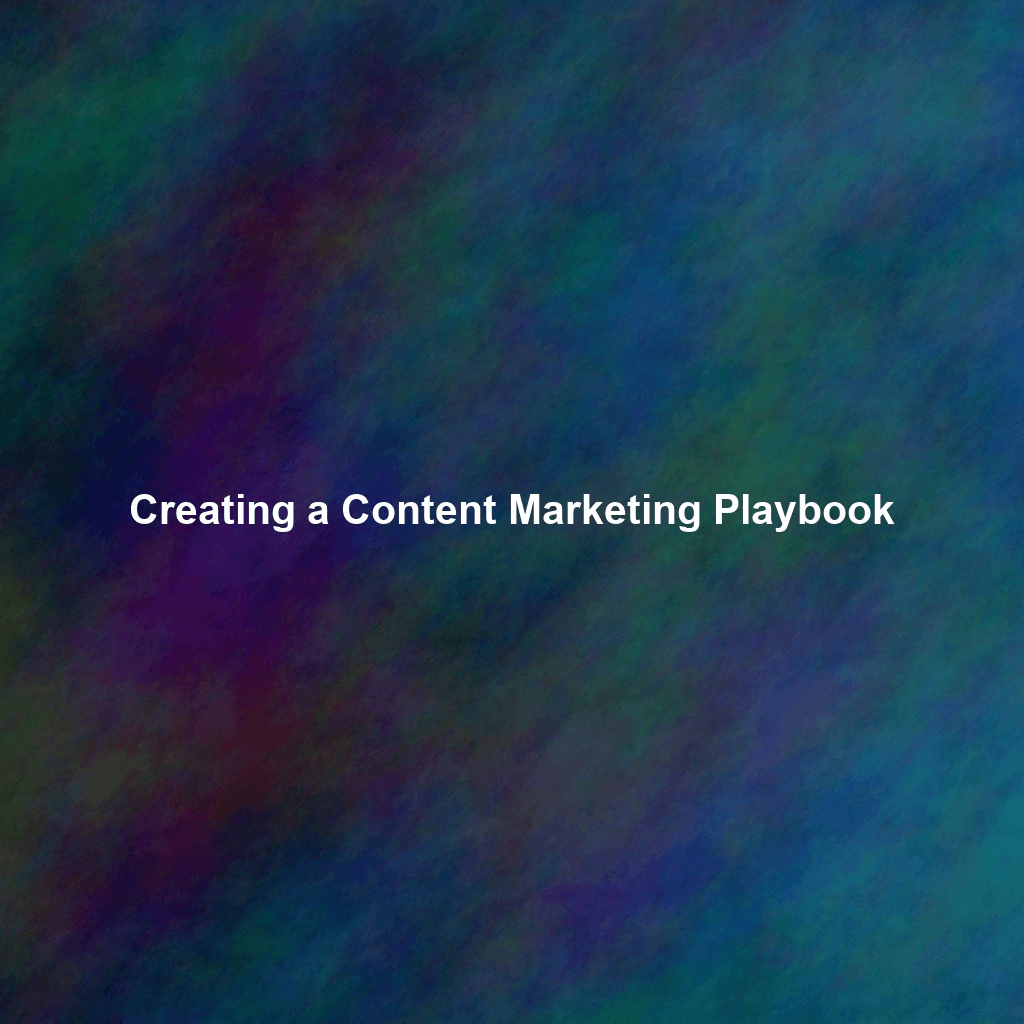Crafting Your Content Marketing Playbook: A Strategic Guide
Content marketing, when done right, isn’t just about churning out blog posts. It’s a strategic endeavor, a carefully orchestrated symphony of content that resonates with your target audience, builds brand authority, and ultimately drives business results. But how do you ensure your content marketing efforts are truly effective? The answer lies in creating a comprehensive content marketing playbook.
Think of your playbook as the ultimate guide to your content marketing strategy. It’s a living document that outlines your goals, target audience, content types, processes, and key performance indicators (KPIs). It ensures everyone on your team is on the same page, working towards the same objectives. Without a playbook, your content marketing can easily become disjointed, inconsistent, and ultimately, ineffective.
Why You Need a Content Marketing Playbook
Before diving into the how-to, let’s solidify the “why.” A well-defined playbook offers numerous benefits:
- Provides Clarity and Direction: Eliminates ambiguity and ensures everyone understands the overall content marketing strategy.
- Ensures Consistency: Maintains a consistent brand voice, style, and message across all content channels.
- Streamlines Content Creation: Defines clear processes for ideation, creation, review, and publication, saving time and resources.
- Improves Collaboration: Facilitates seamless teamwork by outlining roles and responsibilities.
- Enhances Performance Tracking: Establishes KPIs and metrics for measuring the effectiveness of content marketing efforts.
- Supports Scalability: Makes it easier to scale your content marketing efforts as your business grows.
Building Your Content Marketing Playbook: Step-by-Step
Now, let’s get practical. Here’s a step-by-step guide to building a robust and effective content marketing playbook:
1. Define Your Goals and Objectives
What do you want to achieve with your content marketing? Are you aiming to increase brand awareness, generate leads, drive sales, improve customer engagement, or something else entirely? Be specific and measurable. For example, instead of saying “increase brand awareness,” aim for “increase website traffic by 20% within six months.”
Consider using the SMART framework (Specific, Measurable, Achievable, Relevant, Time-bound) to define your goals. This will help you create realistic and trackable objectives.
2. Identify Your Target Audience(s)
Understanding your audience is paramount. Who are you trying to reach? What are their needs, pain points, and interests? What questions are they asking? Where do they spend their time online?
Create detailed buyer personas that represent your ideal customers. Include demographic information, psychographic traits, online behavior, and purchasing habits. The more you know about your audience, the better you can tailor your content to resonate with them.
Go beyond basic demographics. Interview existing customers, conduct surveys, and analyze website analytics to gather in-depth insights. Understanding your audience is a continuous process, so revisit and update your personas regularly.
3. Conduct a Content Audit
Before you start creating new content, take stock of what you already have. A content audit involves reviewing all your existing content assets – blog posts, articles, videos, ebooks, social media updates, etc. – and evaluating their performance.
Assess each piece of content based on factors such as:
- Relevance: Is it still relevant to your target audience?
- Accuracy: Is the information up-to-date and accurate?
- Performance: How well is it performing in terms of traffic, engagement, and conversions?
- SEO: Is it optimized for relevant keywords?
- Quality: Is it well-written, visually appealing, and engaging?
Based on your assessment, categorize each piece of content as:
- Keep: High-performing content that aligns with your goals.
- Update: Content that needs to be refreshed or optimized.
- Rewrite: Content that needs significant improvements.
- Delete: Content that is outdated, irrelevant, or underperforming.
The content audit will help you identify gaps in your content library and opportunities for improvement.
4. Define Your Content Pillars and Topics
Content pillars are the core themes or topics that are most relevant to your business and your target audience. They serve as the foundation for your content strategy.
Identify 3-5 content pillars that align with your business goals and target audience’s interests. For each pillar, brainstorm a list of related subtopics that you can explore in your content.
For example, if you’re a marketing agency, your content pillars might be:
- Content Marketing
- Social Media Marketing
- SEO
- Email Marketing
Under the “Content Marketing” pillar, you could have subtopics like:
- Content Marketing Strategy
- Content Creation
- Content Promotion
- Content Analytics
5. Choose Your Content Formats and Channels
Consider the types of content that resonate best with your target audience and align with your business goals. Common content formats include:
- Blog posts
- Articles
- Ebooks
- White papers
- Infographics
- Videos
- Podcasts
- Case studies
- Webinars
- Social media updates
Also, identify the channels where your target audience spends their time. This could include:
- Your website
- Blog
- Social media platforms (Facebook, Twitter, LinkedIn, Instagram, etc.)
- Email newsletters
- Industry publications
- Online forums
Choose the formats and channels that will allow you to reach your target audience effectively and achieve your content marketing goals. Don’t spread yourself too thin – focus on a few key channels where you can make the biggest impact.
6. Create a Content Calendar
A content calendar is a schedule that outlines when and where you will publish your content. It helps you stay organized, consistent, and on track with your content marketing efforts.
Your content calendar should include:
- Content title
- Content format
- Target keyword
- Target audience
- Publication date
- Publication channel
- Author
- Status (e.g., in progress, review, published)
Use a spreadsheet, project management tool, or dedicated content calendar software to manage your content schedule. Regularly review and update your calendar as needed.
7. Define Your Content Creation Process
Establish a clear and repeatable process for creating content. This will help you streamline your content creation efforts and ensure consistency.
Your content creation process should include steps such as:
- Ideation: Generating new content ideas.
- Research: Gathering information and data for your content.
- Writing: Crafting the content itself.
- Editing: Reviewing and refining the content for grammar, clarity, and accuracy.
- Design: Creating visuals to accompany your content.
- Optimization: Optimizing the content for search engines and readability.
- Review: Getting feedback from stakeholders.
- Publication: Publishing the content on your chosen channels.
Assign roles and responsibilities for each step of the process. Use templates and checklists to ensure consistency and quality.
8. Outline Your Content Promotion Strategy
Creating great content is only half the battle. You also need to promote it effectively to reach your target audience.
Your content promotion strategy should include:
- Social media promotion: Sharing your content on relevant social media platforms.
- Email marketing: Promoting your content to your email subscribers.
- Influencer outreach: Reaching out to influencers in your industry to share your content.
- Guest blogging: Publishing content on other websites to reach a wider audience.
- Paid advertising: Using paid advertising to promote your content on social media or search engines.
- SEO: Optimizing your content for search engines to attract organic traffic.
Tailor your promotion strategy to each piece of content and each channel. Track your results to see what’s working and what’s not.
9. Establish Your Key Performance Indicators (KPIs)
How will you measure the success of your content marketing efforts? Define KPIs that align with your business goals and track them regularly.
Common content marketing KPIs include:
- Website traffic: The number of visitors to your website.
- Engagement: Metrics like time on page, bounce rate, and social shares.
- Lead generation: The number of leads generated through your content.
- Sales: The number of sales generated through your content.
- Conversion rate: The percentage of visitors who take a desired action, such as filling out a form or making a purchase.
- Return on investment (ROI): The profitability of your content marketing efforts.
Use analytics tools to track your KPIs and identify areas for improvement. Regularly report on your progress to stakeholders.
10. Document Your Processes and Guidelines
Finally, document all your processes, guidelines, and best practices in your content marketing playbook. This will ensure that everyone on your team is following the same approach and that your content remains consistent over time.
Include information on:
- Brand voice and style guidelines: How your content should sound and look.
- SEO best practices: Guidelines for optimizing your content for search engines.
- Content creation templates: Standardized templates for different types of content.
- Review and approval workflows: The process for reviewing and approving content before publication.
- Content promotion checklists: Step-by-step guides for promoting your content on different channels.
Make your playbook easily accessible to everyone on your team. Regularly review and update it as needed.
Maintaining and Evolving Your Playbook
Your content marketing playbook isn’t a static document. It’s a living, breathing guide that should evolve as your business, audience, and the content marketing landscape change. Regularly review and update your playbook to ensure it remains relevant and effective.
Consider setting up a quarterly or annual review cycle to assess the performance of your content marketing efforts and identify areas for improvement. Incorporate new insights and best practices into your playbook to stay ahead of the curve.
Conclusion
Creating a content marketing playbook is an investment in the long-term success of your content marketing efforts. By taking the time to define your goals, understand your audience, and document your processes, you can create a powerful tool that will guide your content strategy, improve your results, and help you achieve your business objectives. So, roll up your sleeves, gather your team, and start building your content marketing playbook today!
 Skip to content
Skip to content

